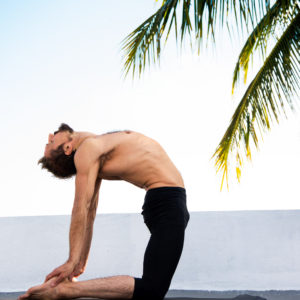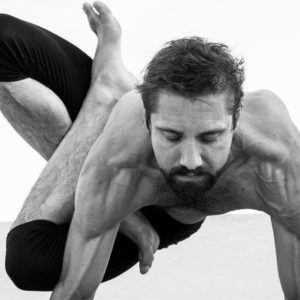The imagery of modern yoga has an ethereal edge. Wherever we look, we see lissome bodies bending into improbable forms, and balancing elegantly on the precipice of medical disaster. This imagery can lend the impression that yoga is for people who live an ethereal existence, people who may be missing bones, who drift through the atmosphere, and rarely touch ground with their feet. But these images are incidental. They do not reflect the profile of the ordinary yoga practitioner. On the contrary, they do something more interesting. They reflect our fascination with the contortive potential of the human body, and in doing so, they symbolize, however imperfectly, our inherent admiration for resilience.
Yogic imagery is remarkably old. It provides the earliest evidence we have for yoga in the ancient world. One of the earliest pieces is the Pashupati seal from the Mohenjo-Daro excavation site in present day Pakistan. It features a humanlike figure with long horns seated in what appears to be Mulabandhasana. The seal predates the current era by more than two millennia, and represents a civilization about which we understand very little. The meaning of the seal is veiled in obscurity, and this is usual for artifacts that pertain to the ancient origins of yoga. Sometimes we can decode their symbology enough to tell a coherent story about what they might mean, but we can only imagine the consciousness in which they were composed.
Throughout its long and complicated history, yoga has formed countless alliances with diverse alchemical and soteriological traditions. In light of the diversity, many scholars now argue that there is no single thing called “yoga” whose tradition we can trace. And so that may be. But if we look at examples of yogic imagery throughout the ages—from the ancient seals of the Indus River Valley, to the medieval temple carvings of Tamil Nadu, to the Kalighat paintings of colonial Bengal, and to the crystalline images that stream through our social media channels today—there is always that ethereal edge. There is always that evident longing to elevate consciousness above our limitations, and so to enrich and expand the human experience.
This ethereal edge is the common thread to what we recognize as yogic imagery. And if we can follow that thread through the ages, weaving through countless social and ritual contexts, this is arguably because of the way that what we recognize as yoga practice answers an archetypal human need—the need to be resilient, to be malleable, and to meet the persistent pressures to adapt to the ever changing circumstance of life. That need has been understood in diverse and often opposing ways, as demonstrated by the Vedic, Tantric, and Advaitic approaches to the problem. Arguably no single one of these is definitive, but neither can any one of them be discounted. What is pertinent is the way that each of them answers our felt need to break up our inveterate patterns of conditioning, open our minds and evolve.

Modern yoga does not cohere around any particular philosophy. It exists more simply as an open set of practices and techniques for helping us overcome our psychological limitations. Whatever the promises of yoga practice might be, the most pertinent and most compelling is that yoga allows us to relate more openly to otherness. The practice teaches us to hold an open space of compassionate awareness for our own thoughts, emotions and memories to unfold, no matter how excessive or threatening they might seem. Through this practice, we give ourselves space, and we allow our minds to breath, so that otherness can appear within our consciousness, and we can relate to it more openly, without being impeded by our fears and anxieties. That is, we can receive otherness, and be impacted by otherness, adapting to its reality without having to reinforce any particular idea or image of ourselves in the process.
The reception of otherness within ourselves helps break up our self images. And in this sense, the practices of yoga are vehicles for psychical release. They help us release ourselves from the tangles of thought, emotion and memory to which we so ardently cling. They help us to let go of things, so that we do not congeal into the imprint of our experiences, but we can continue to change and adapt to our circumstances. To put it simply, the techniques of yoga help us break ourselves up. They help us break up the congestion of our delusions and conceits, piercing the armor by which we conceal and protect ourselves from the otherness of the world. And in doing so, they help us liberate ourselves from the stagnation of our conditioning, so we can open ourselves to new relationships, and new possibilities of experience.
The orphanage of modern yoga practices from the historical traditions from which they descend is often regarded as corrosive to their potency, but arguably the reverse is true. However rich and compelling those traditions might be, it remains essential that we translate our experiences with yoga into our own living language, into words that bring those experiences home to us, and engage us as we are. The elision of antiquated concepts from the language of yoga is therefore an essential and not entirely regrettable aspect of its adaptation to modern life. Without imposing upon ourselves the arcane limitations of historically distant ideas, we can have a more authentic experience of ourselves through the practice. The removal of those ideas means that we can give ourselves more room to breathe, more room to settle into ourselves, and more room to follow the currents of awakening that are already flowing through us.
This is part of the intelligence of modern yoga. As a global phenomenon, yoga is not bound too tightly to any particular philosophy, nor to any particular conception of the relationship between the human and the divine. And for just that, it can focus on what is more compelling, namely, the process of breaking up the self, and creating more space for the natural processes of creativity to unfold. There are, of course, people today who would argue endlessly about the relative credentials of dualism, non-dualism, monism and the like, but the modern yoga movement is largely agnostic on these speculative questions, and understandably so. In these late modern times, we have no need for the kind of thinking that hangs so breathlessly on these delicate distinctions, and evidence abounds of the problems that arise when we allow that kind of thinking to congeal into certainty. Moreover, the speculative questions that underlie these distinctions tend to lose their force under the softening influence of the yogic experience, and that experience is really the center of the attraction.

What holds the attention of most modern yoga practitioners is not any particular view of reality that may or not be encouraged by the practice, but the immediate experience of psychical release that is so warmly invited by each and every breath. The most intriguing thing about yoga practice is that it works—when we undertake the practice assiduously, without pause, for a reasonable amount of time, we find that we can break into ourselves, creating space within our minds to relate to otherness in a more open and authentic way. And here is the point—it is only by relating openly and authentically to otherness that we can evolve, for it is precisely in relation to otherness that we express creativity, awareness, compassion, and resilience.
So the process of breaking into ourselves, and creating space for otherness, is crucial for our psychological development. And we all could use some kind of internal practice to help make that process unfold, for we all tend to stagnate into our own psychological patterns. This is perhaps the fundamental problem that yoga practice has always been called upon to solve, the problem of pulling us from the mire of our own conditioning. This problem is arguably more pressing now then ever. Modern life, after all, draws us into extremes of isolation, where we shun our collective problems with dangerous apathy. It is perhaps no coincidence, then, that an unprecedented collective effort is the only chance that we have to reverse our destructive patterns today and resolve the colossal problems of our time. At this pivotal moment in history, when we have nuclear weapons pointed all over the globe, and our patterns of extraction and consumption are quickly destroying the conditions of human life on our planet, our survival depends on our ability to break our conditioned patterns of thinking and acting, to come out of ourselves, to recognize the stark reality of our crises, and then to join together, with the rest of humanity, to take radical and immediate measures to cope intelligently with our nearly apocalyptic problems.
Today, we can no longer afford to limit yoga to spiritual purposes. Yoga is perhaps the most powerful instrument that we have for breaking out of ourselves and overcoming the paralyzing effects of our psychological conditioning. On the same account, we can no long afford to restrict access to yoga, or create divisions within yoga that reinforce that archaic and destructive “us-versus-them” mentality. What we think of as “real” yoga might not be for everyone (or anyone living now for that matter) but everyone today needs the kind of provocation to openness and change that even the more popular forms of yoga can inspire. The real yoga is not the one that comes down to us through this or that authority, but the one that rattles us out of our delusions, draws us out ourselves, and exposes us to the fact that we are not isolated from one another, but bound together inextricably, and tasked to find ways of living together that express our basic resilience, kindness and generosity.
The popularization of yoga, whatever its drawbacks might be, can help to inspire this kind of realization, by giving us simple and compelling methods for breaking up our mental congestions and our practical stagnations, and dissolving the individual and collective delusions that obscure our deeper and more loving nature. This is something that we can all support without reservation, if we can only set ourselves aside, and look at the bigger picture. Instead of creating more divisive hierarchies, more elitist obscurations, or more structures of restricted access and protected privilege, we should work together to churn the collective mind, uncover the potent essence of yoga, and then allow it to flow, so we can share it with absolutely everyone.
By Ty Landrum

Have you tried Ty’s Ashtanga course on Omstars? He explores techniques and tips for jumping through and jumping back, the energies of prana and apana in practice and also teaches a full primary series practice as well! Stay tuned for more articles and courses from Ty on Omstars, but in the meantime you can read more of Ty’s brilliant articles on his website tylandrum.com!










